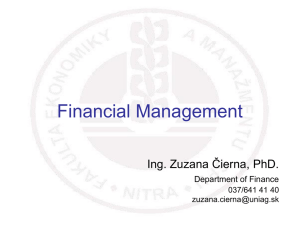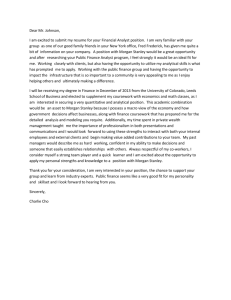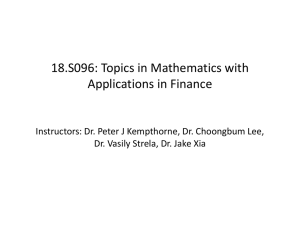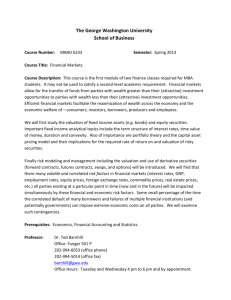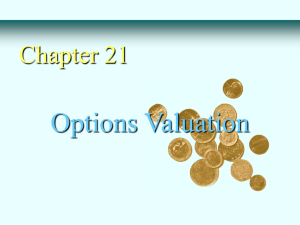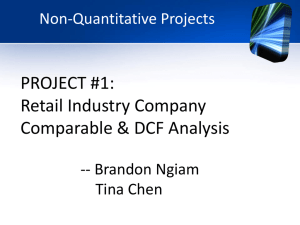Risk Neutral Pricing Black-Scholes Formula Lecture 19 Dr. Vasily Strela
advertisement
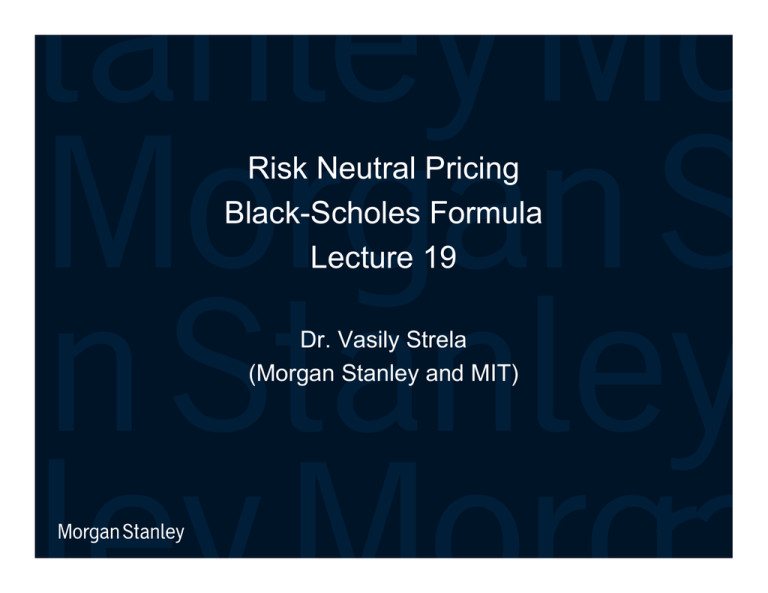
Risk Neutral Pricing Black-Scholes Formula Lecture 19 Dr. Vasily Strela (Morgan Stanley and MIT) Risk Neutral Valuation: Two-Horse Race Example One horse has 20% chance to win another has 80% chance $10000 is put on the first one and $50000 on the second If odds are set 4-1: • Bookie may gain $10000 (if first horse wins) • Bookie may loose $2500 (if second horse wins) • Bookie expects to make 0.2 * (10000) + 0.8 * (-2500) = 0 If odds are set 5-1: • Bookie will not lose or gain money no matter which horse wins 2 Risk Neutral Valuation : Introduction We are interested in finding prices of various derivatives. Forward contract pays S-K at time T : Forward Contract 150 100 50 F(t,S) F(T,S) 0 0 20 40 60 80 100 120 140 160 180 200 -50 -100 S(t)=80, K=88.41, T=2 (years) 3 Risk Neutral Valuation: Introduction European Call option pays max(S-K,0) at time T European Call Option 140 120 100 80 C(t,S) 60 C(T,S) 40 20 0 -20 0 20 40 60 80 100 120 140 160 180 200 S(t)=80, K=80, T=2 (years) 4 Risk Neutral Valuation: Introduction European Put option pays max(K-S,0) at time T European Put Option 90 80 70 60 50 P(t,S) 40 P(T,S) 30 20 10 0 -10 0 20 40 60 80 100 120 140 160 180 200 S(t)=80, K=80, T=2 (years) 5 Risk Neutral Valuation: Introduction Given current price of the stock and assumptions on the dynamics of stock price, there is no uncertainty about the price of a derivative The price is defined only by the price of the stock and not by the risk preferences of the market participants Mathematical apparatus allows to compute current price of a derivative and its risks, given certain assumptions about the market 6 Risk Neutral Valuation: Replicating Portfolio Consider Forward contract which pays S-K in time dt. One could think that its strike K should be defined by the “real world” transition probability p: p(S1-K)+(1-p)(S2-K)=pS1+(1-p)S2-K K0= pS1+(1-p)S2 If p=1/2, K0=(S1+S2)/2 7 Risk Neutral Valuation: Replicating Portfolio Consider the following strategy: 1. Borrow $S0 to buy the stock. Enter Forward contract with strike K0 2. In time dt deliver stock in exchange for K0 and repay $S0erdt • • If K0> S0erdt we made riskless profit If K0< S0erdt we definitely lost money K 0 S0 erdt Current price of a derivative claim is determined by current price of a portfolio which exactly replicates the payoff of the derivative at the maturity 8 Risk Neutral Valuation: One step binomial tree Suppose our economy includes stock S, riskless money market account B with interest rate r and derivative claim f. Assume that only two outcomes are possible in time dt: S1, B0erdt, f1 p S0, B0, f0 1-p S2, B0erdt, f2 9 Risk Neutral Valuation: One step binomial tree For a general derivative claim f, find a and b such that f1=aS1+bB0erdt f2=aS2+bB0erdt Then f0=aS0+bB0 Easy to see that f1 f2 S1 f2 S2 f1 a ,b S1 S2 (S1 S2 )B0 e rdt f0 e rdt rdt f1 f2 S1 f2 S2 f1 S0 e S1 S2 S1 S2 10 Risk Neutral Valuation: One step binomial tree One should notice that f0 e rdt S0 erdt S2 S1 S0 erdt f2 f1 S1 S2 S1 S2 f0 = e-rdt(f1q + f2(1 - q)) where q=(S0erdt-S2)/(S1-S2), 0<q<1 Moreover S1q+S2(1-q)= erdtS0 11 Risk Neutral Valuation: Continuous case ft=e-r(T-t)EQ[fT] Q is the risk neutral (martingale) measure under which S0=e-rtEQ[St] 12 Black-Scholes equation Assume that the stock has log-normal dynamics: dS = Sdt + SdW Where dW is normally distributed with mean 0 and standard deviation dt (i.e. W is a Brownian Motion) We want to find a replicating portfolio such that df = adS + bdB 13 Black-Scholes equation Use Ito’s formula: f f 1 f 2 df (S, t) dt dS (dS) t S 2 S 2 2 (dS)2 2 S 2 dt (analogous to first order Taylor expansion, up to dt term) 14 Black-Scholes equation df=adS+bdB Substitute dS, df, dB=rBdt and (dS ) 2 f f 1 2 f 2 2 f S dt SdW (a S brB)dt a SdW S 2 2 S S t S Compare terms f f 1 2 f 2 2 a , brB S 2 S t 2 S 15 Black-Scholes equation bB=f-aS is deterministic and as dB=rBdt d(f-aS)=r(f-aS)dt f f 1 2 f 2 2 f and a S dt Substituting once again df dt dS S 2 S 2 t S we obtain the Black-Scholes equation f 1 2 f 2 2 f S rS rf 0 2 t 2 S S Fisher Black, Myron Scholes – paper 1973 Myron Scholes, Robert Merton – Nobel Prize 1997 16 Black-Scholes equation • Any tradable derivative satisfies the equation • There is no dependence on actual drift • We have a hedging strategy (replicating portfolio) • By a change of variables Black-Scholes equation transforms into heat equation u 2u 2 x 17 Black-Scholes equation Boundary and final conditions are determined by the pay-off of a specific derivative For European Call C(S,T)=max(S-K,0) C(0, t) 0, C(, t) S For European Put P(S,T)=max(K-S,0) P(0,t) Ke r (T t ) , P(,t) 0 18 Black-Scholes equation For European Call/Put the equation can be solved analytically Ct er(T t ) er(T t ) SN(d1 ) KN(d2 ) Pt er(T t ) KN(d2 ) er(T t ) SN(d1 ) where ln(S / K ) (r 2 / 2)(T t) d1 T t ln(S / K ) (r 2 / 2)(T t) d2 T t 1 N(x) 2 x e u2 /2 du 19 Black-Scholes: Risk Neutral Valuation ft=e-r(T-t)EQ[fT] Q is the risk neutral measure under which dS=rSdt+SdW (ln(ST / St ) (r 2 / 2)(T t))2 1 exp PDF(ST ) 2 2 (T t) S 2 T 20 Black-Scholes equation For more complicated options or more general assumptions numerical methods have to be used: • Finite difference methods • Tree methods (equivalent to explicit scheme) • Monte Carlo simulations 21 Black-Scholes equation: Conclusions Modern financial services business makes use of • • • • PDE Numerical methods Stochastic Calculus Simulations • • Statistics Much, much more 22 Risk Neutral Valuation: Example Source: Bloomberg L.P. 23 Risk Neutral Valuation: Example Digital option pays 1 if S>K at time T Digital Option 1.2 1 0.8 0.6 D(t,S) D(T,S) 0.4 0.2 0 0 20 40 60 80 100 120 140 160 180 200 -0.2 S(t)=80, K=80, T=2 (years) 24 Disclosures The information herein has been prepared solely for informational purposes and is not an offer to buy or sell or a solicitation of an offer to buy or sell any security or instrument or to participate in any trading strategy. Any such offer would be made only after a prospective participant had completed its own independent investigation of the securities, instruments or transactions and received all information it required to make its own investment decision, including, where applicable, a review of any offering circular or memorandum describing such security or instrument, which would contain material information not contained herein and to which prospective participants are referred. No representation or warranty can be given with respect to the accuracy or completeness of the information herein, or that any future offer of securities, instruments or transactions will conform to the terms hereof. Morgan Stanley and its affiliates disclaim any and all liability relating to this information. Morgan Stanley, its affiliates and others associated with it may have positions in, and may effect transactions in, securities and instruments of issuers mentioned herein and may also perform or seek to perform investment banking services for the issuers of such securities and instruments. The information herein may contain general, summary discussions of certain tax, regulatory, accounting and/or legal issues relevant to the proposed transaction. Any such discussion is necessarily generic and may not be applicable to, or complete for, any particular recipient's specific facts and circumstances. Morgan Stanley is not offering and does not purport to offer tax, regulatory, accounting or legal advice and this information should not be relied upon as such. Prior to entering into any proposed transaction, recipients should determine, in consultation with their own legal, tax, regulatory and accounting advisors, the economic risks and merits, as well as the legal, tax, regulatory and accounting characteristics and consequences, of the transaction. Notwithstanding any other express or implied agreement, arrangement, or understanding to the contrary, Morgan Stanley and each recipient hereof are deemed to agree that both Morgan Stanley and such recipient (and their respective employees, representatives, and other agents) may disclose to any and all persons, without limitation of any kind, the U.S. federal income tax treatment of the securities, instruments or transactions described herein and any fact relating to the structure of the securities, instruments or transactions that may be relevant to understanding such tax treatment, and all materials of any kind (including opinions or other tax analyses) that are provided to such person relating to such tax treatment and tax structure, except to the extent confidentiality is reasonably necessary to comply with securities laws (including, where applicable, confidentiality regarding the identity of an issuer of securities or its affiliates, agents and advisors). The projections or other estimates in these materials (if any), including estimates of returns or performance, are forward-looking statements based upon certain assumptions and are preliminary in nature. Any assumptions used in any such projection or estimate that were provided by a recipient are noted herein. Actual results are difficult to predict and may depend upon events outside the issuer’s or Morgan Stanley’s control. Actual events may differ from those assumed and changes to any assumptions may have a material impact on any projections or estimates. Other events not taken into account may occur and may significantly affect the analysis. Certain assumptions may have been made for modeling purposes only to simplify the presentation and/or calculation of any projections or estimates, and Morgan Stanley does not represent that any such assumptions will reflect actual future events. Accordingly, there can be no assurance that estimated returns or projections will be realized or that actual returns or performance results will not be materially different than those estimated herein. Any such estimated returns and projections should be viewed as hypothetical. Recipients should conduct their own analysis, using such assumptions as they deem appropriate, and should fully consider other available information in making a decision regarding these securities, instruments or transactions. Past performance is not necessarily indicative of future results. Price and availability are subject to change without notice. The offer or sale of securities, instruments or transactions may be restricted by law. Additionally, transfers of any such securities, instruments or transactions may be limited by law or the terms thereof. Unless specifically noted herein, neither Morgan Stanley nor any issuer of securities or instruments has taken or will take any action in any jurisdiction that would permit a public offering of securities or instruments, or possession or distribution of any offering material in relation thereto, in any country or jurisdiction where action for such purpose is required. Recipients are required to inform themselves of and comply with any legal or contractual restrictions on their purchase, holding, sale, exercise of rights or performance of obligations under any transaction. Morgan Stanley does not undertake or have any responsibility to notify you of any changes to the attached information. With respect to any recipient in the U.K., the information herein has been issued by Morgan Stanley & Co. International Limited, regulated by the U.K. Financial Services Authority. THIS COMMUNICATION IS DIRECTED IN THE UK TO THOSE PERSONS WHO ARE MARKET COUNTERPARTIES OR INTERMEDIATE CUSTOMERS (AS DEFINED IN THE UK FINANCIAL SERVICES AUTHORITY’S RULES). ADDITIONAL INFORMATION IS AVAILABLE UPON REQUEST. 25 MIT OpenCourseWare http://ocw.mit.edu 18.S096 Topics in Mathematics with Applications in Finance Fall 2013 For information about citing these materials or our Terms of Use, visit: http://ocw.mit.edu/terms.

